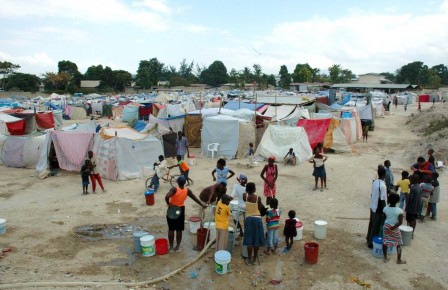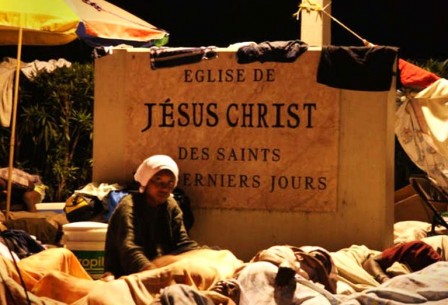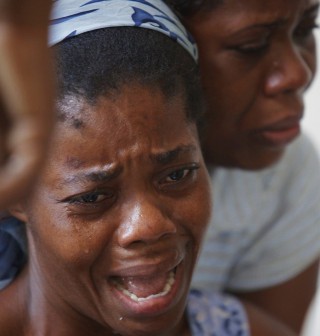Haiti: Will Cholera Spread To Port-au-Prince’s Tent Cities?
Yesterday, the United Nations raised concerns, and urged the international community for action to deal with the real possibility of a nationwide cholera epidemic in Haiti. Since the outbreak from last week, in the earthquake ravaged island, 259 people have died from cholera. According to the UN, and several NGOs, the number of cases currently stands at 3,000.
Efforts to contain the spread of the disease is now the top priorities for humanitarian agencies, which are trying to prevent the epidemic from reaching the camps still housing up to a million people left homeless by the massive earthquake in January. The UN World Health Organization and Haiti’s health ministry have already confirmed five cholera cases in the capital Port-au-Prince, but apparently the patients were infected while visiting the Artibonite region of the island, where the cholera outbreak started.
“The consequences of the epidemic reaching the cities-a very real prospect- would be devastating to all, including those still living in camps after the earthquake,” said Nigel Fisher, the UN Humanitarian Coordinator in Haiti.
Cholera is an acute waterborne disease which if left untreated can kill within hours. It is an intestinal infection caused by eating food or drinking water contaminated with the bacteria known as Vibrio Cholerae. Symptoms include vomiting, watery diarrhoea which can quickly lead to severe dehydration and death if not treated immediately.
“This is an extremely serious situation, and based on experience with epidemics elsewhere, it would be irresponsible to plan for anything but a considerably wider outbreak. We are particularly concerned about Port-au-Prince and those in the slum areas as well as in the camps, but we are also preparing for outbreaks in the rest of the country,” said Fisher with the UN.
Meanwhile, Doctors Without Borders is preparing for the possibility that the disease could spread. At the moment the organization can treat cholera at eight of its facilities in the Artibonite region and in and around the capital Port-au-Prince. Doctors Without Borders announced yesterday that a cargo plane with 100 tons of medical supplies flew into Haiti from Europe on Monday. The organization is also putting together an emergency field hospital to be used as a cholera treatment center on a football field near St Nicholas Hospital. The facility is scheduled to be operational on Wednesday.
“The best way to contain the spread of cholera is through prevention, and ensuring that people have access to clean drinking water. In refugee settings in conflict areas, people are forced to seek water wherever they can find it,” said Dr David Olson, Doctors Without Borders’ medical adviser and cholera specialist in Haiti.
Nine months after the earthquake, hundred of thousands of internal refugees still live in squalid and appalling conditions in the make shift tent city camps. Many survivors have to cook and wash near toilets or even pool of human wastes. These are ideal conditions for an outbreak of cholera. In the overflowing Champs De Mars camp, in Port-au-Prince, the toilets are right next to the tents where survivors live. As a global community, we have dropped the ball on helping Haiti rebuild, and once again Haitians are paying the price.
Since I published the first version of this article, it was brought to my attention both on Twitter and Facebook, that ultra-conservative GOP US Senator Coburn was behind blocking the US aid package pledged by the US to Haiti. After some research, I found out that the obstructionism of Senator Coburn was only a small piece of a puzzle of this disturbing global failure. The best document on the mechanics of this unacceptable fiasco comes from an academic study. The 56 pages long study, conducted under the supervision of Mark Schuller was made during the summer of 2010. The study involved more than 100 camps of Internally Displaced Persons (IDP).
“The result show that despite the billions in aid pledged to Haiti, most of the estimated 1.5 million IDP are living in substandard conditions. For example, seven months following the earthquake 40 percent of IDP camps do not have access to water, and 30 percent do not have toilets of any kind,” says the 56 pages study. To view some of the best photographs of Haiti’s cholera outbreak click here.
Editor’s Note: Even if your respective government has dropped the ball on helping Haiti in dire times of need, you don’t have to. The best way to help Haitians right now, in this new medical emergency, is to support and donate to Medecins Sans Frontieres ( Doctors Without Borders). You can donate here.
Related Articles
















9 Responses to Haiti: Will Cholera Spread To Port-au-Prince’s Tent Cities?
You must be logged in to post a comment Login